What is a Husky? The Siberian Husky is a medium size working dog breed that originated in north-eastern Siberia, Russia. The breed belongs to the Spitz genetic family. It is recognizable by its thickly furred double coat, erect triangular ears, and distinctive markings.
The original Siberian Huskies were bred by the Chukchi people — whose hunter-gatherer culture relied on their help. It is an active, energetic, resilient breed, whose ancestors lived in the extremely cold and harsh environment of the Siberian Arctic. William Goosak, a Russian fur trader, introduced them to Nome, Alaska during the Nome Gold Rush, initially as sled dogs. The people of Nome referred to the Siberian Huskies as “Siberian Rats” due to their size of 40–50 lbs. compared with the Malamute dogs, 75–85 lbs.
Husky Traits and Characteristics
Origin: Siberia, Russia.
- Extremely energetic. Loves to run (they make great jogging companions).
- Weight: Male 45–60 pounds (20–27 kg), Female 35–50 pounds (16–23 kg).
- Height: Male 21–24 inches (53–61 cm), Female 18–20 inches (46–51 cm).
- Coat: Thick double coat – thick undercoat and soft outer coat. We cannot stress this enough. Huskies SHED. They shed to the point that you will think your dog is going bald. Be prepared with a powerful vacuum and time for lots of brushing.
- Color: White, Agouti, Black, Piebald, Black & Tan, Splash, Black & White, Silver, Red, Copper, Brown, Sable, Grey. Amazing physical endurance.
- Life span: 12–15 years.
- Highly social : huskies are quick to make friends with complete strangers.
- High predatory instincts : Preys on smaller animals like squirrels and birds but does not exclude cats (depending on the individual dog some have been known to live happily alongside a feline companion)
- Siberian Huskies are independent, athletic, and intelligent. Despite their relatively gentle demeanor and affectionate behavior, they are not easily trained.
Siberian Husky Eyes
In addition to the splendid variety of coat colors available, Siberian Huskies may also have a variety of eye colors. As with coat color, all colors and color combinations are acceptable, no color should be given preference in the show ring. Please note that bi-eyed or parti-eyed dogs are not inherently mixed breed dogs as many who don’t know the breed apparently assume.

Siberian Husky Coat Types and Colors
A Siberian Husky’s coat is thicker than that of most other dog breeds, comprising two layers: a dense undercoat and a longer topcoat of short, straight guard hairs that require grooming. It protects the dogs effectively against harsh Arctic winters, but the coat also reflects heat in the summer. It is able to withstand temperatures as low as −50 to −60 °C (−58 to −76 °F). The undercoat is often absent during shedding. Their thick coats require weekly grooming.
Siberian Huskies come in a variety of colors and patterns, usually with white paws and legs, facial markings, and tail tip. The most common coats are black and white, then less common copper-red and white, grey and white, pure white, and the rare “agouti” coat, though many individuals have blondish or piebald spotting. Striking masks, spectacles, and other facial markings occur in wide variety.
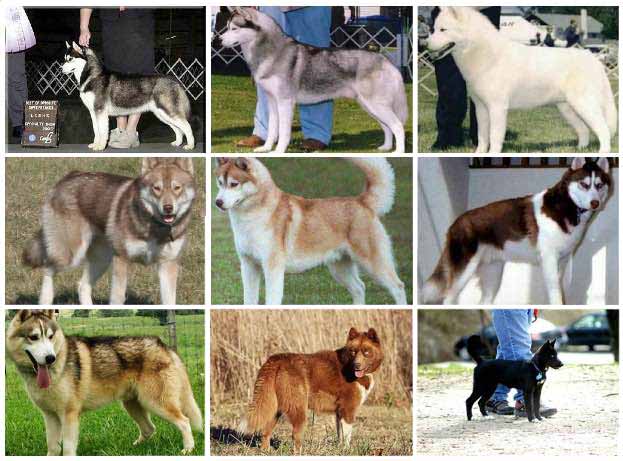
Husky Nose
Show-quality dogs are preferred to have neither pointed nor square noses. The nose is black in gray dogs, tan in black dogs, liver in copper-colored dogs, and may be light tan in white dogs. In some instances, Siberian Huskies can exhibit what is called “snow nose” or “winter nose.” This condition is called hypopigmentation in animals. “Snow nose” is acceptable in the show ring.
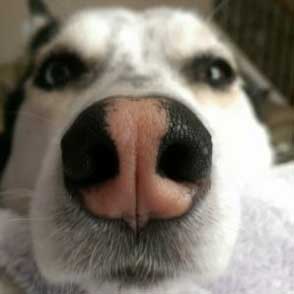
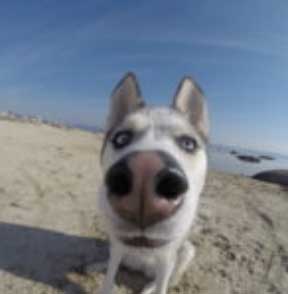
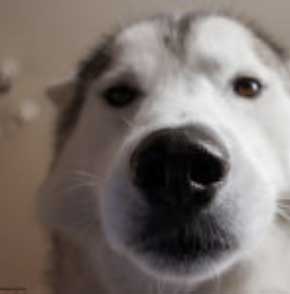
Siberian Husky Tail

Siberian Husky Behavior
Siberian Huskies howls rather than barks. They have been described as escape artists, which can include digging under, chewing through, or even jumping over fences.
Because the Siberian Husky had been raised in a family setting by the Chukchi and not left to fend for themselves they could be trusted with children. The ASPCA classifies the breed as good with children. It also states they exhibit high energy indoors, have special exercise needs, and may be destructive “without proper care”.
Siberian Huskies have a high prey drive due to the Chukchi allowing them to roam free in the summer. The dogs hunted in packs and preyed on wild cats, birds, and squirrels, but with training can be trusted with other small animals. They would only return to the Chukchi villages when the snow returned and food became scarce. Their hunting instincts can still be found in the breed today.
A 6 ft (1.83 m) fence is recommended for this breed as a pet to prevent the Husky from escaping, although some have been known to overcome fences as high as 8 ft (2.44 m). Electric pet fencing may not be effective. They need the frequent companionship of people and other dogs, and their need to feel as part of a pack is very strong.
A fifteen-minute daily obedience training class has been shown to serve well for Siberian Huskies. Siberians need consistent training and do well with a positive reinforcement training program. They rank 54th in Stanley Coren’s The Intelligence of Dogs, being of average working/obedience intelligence.
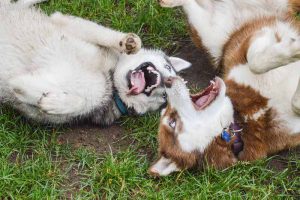
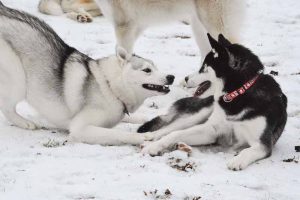
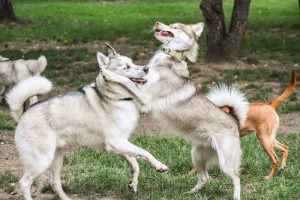
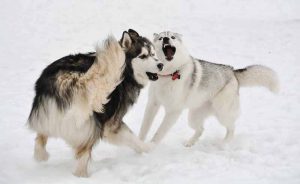
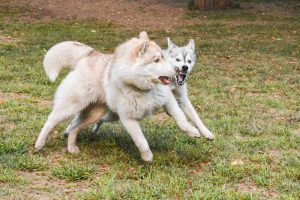

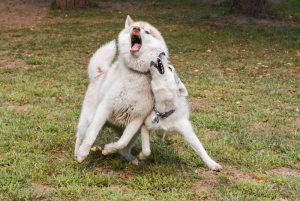
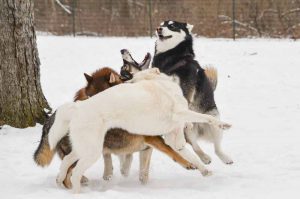
Husky Characteristics
When you think “sled dog,” you’re probably imagining a Siberian Husky. And with good reason — Huskies have done some amazing work pulling sleds. Siberian Huskies once saved an entire town in Alaska — a team of these fearless adventurers brought diphtheria medication to Nome during an outbreak. There is a statue commemorating the lead dog’s efforts in New York’s Central Park (as famously featured in the film Six Degrees of Separation), and the Iditarod Trail Sled Race is run every year in memory of the team’s accomplishments.
This breed was developed by the Chukchi, indigenous peoples of Siberia, to work — and survive — the harsh conditions of the Arctic region. Their extremely dense coats allow them to withstand extreme cold. Amazingly, these dogs can even change their metabolisms, allowing them to go long distances without fatigue or using up their fat stores.
Huskies are known for a few other distinctive characteristics as well. They’re notorious howlers — you can hear a Husky’s voice carry for miles. And these dogs often have striking blue eyes. (Don’t worry; they’re not “White Walkers.” They’re supposed to look like that.)
Originally from Russia, the Husky is considered medium-sized and high-energy breed can grow to between 35-60 pounds and lives an average of 12-15 years. The breed is recognized by the American Kennel Club and classified as a member of the Working group.
Siberian Husky Lineage
In 1989, a study was made of ancient canid remains dated to the Late Pleistocene and early Holocene that had been uncovered by miners decades earlier around Fairbanks, Alaska. These were identified as Canis lupus and described as “short-faced wolves”. The collection was separated into those specimens that looked more wolf-like, and those that looked more dog-like and in comparison to the skulls of Eskimo dogs from both Greenland and Siberia thought to be their forerunners.
In 2015, a study using a number of genetic markers indicated that the Siberian Husky, the Alaskan Malamute and the Alaskan husky share a close genetic relationship between each other and were related to Chukotka sled dogs from Siberia. They were separate to the two Inuit dogs, the Canadian Eskimo Dog and the Greenland dog. In North America, the Siberian Husky and the Malamute both had maintained their Siberian lineage and had contributed significantly to the Alaskan husky, which showed evidence of crossing with European breeds that were consistent with this breed being created in post-colonial North America.
Nearly all dog breeds’ genetic closeness to the gray wolf is due to admixture. However, several Arctic dog breeds show a genetic closeness with the now-extinct Taymyr wolf of North Asia due to admixture. These breeds are associated with high latitudes – the Siberian Husky and Greenland dog that are also associated with arctic human populations and to a lesser extent, the Shar Pei and Finnish spitz. An admixture graph of the Greenland dog indicates a best-fit of 3.5% shared material, however an ancestry proportion ranging between 1.4% and 27.3% is consistent with the data. This indicates admixture between the Taymyr wolf population and the ancestral dog population of these 4 high-latitude breeds. This introgression could have provided early dogs living in high latitudes with phenotypic variation beneficial for adaption to a new and challenging environment. It also indicates the ancestry of present-day dog breeds descends from more than one region.
History and Background of the Siberian Husky
Native to Siberia, the Siberian Husky was brought to Alaska in 1909. The Siberian Husky was originated by the Chukchi people of northeastern Asia as an endurance sled dog. When changing conditions forced these semi-nomadic natives to expand their hunting grounds, they responded by developing a unique breed of sled dog, which met their special requirements and upon which their very survival depended.
In the winter of 1925, when a diphtheria epidemic broke out in the isolated town of Nome, Alaska, a relay of dog teams brought life-saving serum from distant Nenana. This heroic endeavor earned national prominence for the drivers and their dogs. One of these drivers, Leonard Seppala, brought his team of Siberian Huskies, descendants of the original imports from Siberia, to the United States on a personal appearance tour. While in New England he competed in sled dog races and again proved the superiority of Siberian Huskies over the native dogs. The New England drivers and pioneer fanciers acquired foundation stock, earned AKC recognition for the breed in 1930, and founded the Siberian Husky Club of America in 1938.

Interested in adopting a Husky? View the available dogs looking for a forever home!

